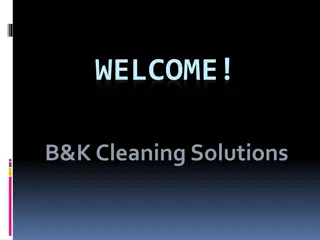Innovations in Winery Cleaning Chemistry for Sustainability
Explore the future of winery cleaning chemistry through leveraging technology and sustainable practices. Considerations for chemistry selection focusing on safety, hazardous materials, employee well-being, and environmental impact are highlighted. Current cleaning chemistry practices, including the use of organic acids and ions, are discussed with an emphasis on minimizing adverse effects. Future cleaning chemistry considerations involve cleaning dirt, disinfection, and biofilm removal for enhanced winery cleaning processes.
Download Presentation

Please find below an Image/Link to download the presentation.
The content on the website is provided AS IS for your information and personal use only. It may not be sold, licensed, or shared on other websites without obtaining consent from the author. Download presentation by click this link. If you encounter any issues during the download, it is possible that the publisher has removed the file from their server.
E N D
Presentation Transcript
Future of Winery Cleaning Chemistry Bob Coleman Leveraging Technology to Increase Sustainability January 25, 2023
Considerations for Chemistry Selection Safety / Hazardous Chemistry Employee Environment Persistence Soil detriment / interaction Recapture & Reuse Water Chemistry Wastewater Treatment pH Microbial break down Electrical energy cost
Considerations for Chemistry Selection Paired Potassium-Based Buffers for Sanitizing Winery Equipment and the Carbon, Nitrogen, Sodium, and Phosphorus Footprints of Winery Cleaning Practices Roger Boulton Advances in Wine Research. January 1, 2015, 379-387 DOI: 10.1021/bk-2015-1203.ch024
Considerations for Chemistry Selection Basic of Green Chemistry EPA www.epa.gov/greenchemistry/basics-green-chemistry
Current Cleaning Chemistry Organic acids for cleaning citric acid peracetic acid adds COD, BOD and energy cost for wastewater treatment Ions and gases for cleaning Na, PO4, nitrogen-based cleaners, Cl2, ClO2, O3, steam safety, soil, water, and/or environmental persistence
Current Cleaning Chemistry Organic acids for cleaning citric acid peracetic acid adds COD, BOD and energy cost for wastewater treatment Ions and gases for cleaning Na, PO4, nitrogen-based cleaners, Cl2, ClO2, O3, steam safety, soil, water, and/or environmental persistence Ideally avoid or minimize the practices above
Future Cleaning Chemistry Considerations Cleaning dirt (cells, tartrate, pulp, suspended solids) Disinfection Biofilm removal
Future Cleaning Chemistry Inorganic base for cleaning Potassium Hydroxide K+ OH- Inorganic acid for cleaning Potassium Bisulfate KHSO4 not to be confused with SO2 or bisulfite used to adjust pH in food K+ Remove of sodium and organic acids from our practices
Future Cleaning Chemistry Combine: 20 mM K2SO4 pH 7.0 No COD No BOD Ideal for wastewater ponds 20mM KOH 20mM KHSO4 + (pH 11.5) (pH 2.5) Basic Wash Acid Wash Ambient Temperature?
Future Cleaning Chemistry Combine: 20 mM K2SO4 pH 7.0 No COD No BOD Ideal for wastewater ponds 20mM KOH 20mM KHSO4 + (pH 11.5) (pH 2.5) Instead recapture and reuse Basic Wash Acid Wash
Future Cleaning Chemistry Rejected Permeate Recapture and Reuse water microbes Nano filter solutions separately post-use reclaim chemistry, water, H2O2 at least 50% recovery of water most critical properly size filtration equipment for: daily cleaning use volume ~16 hours of actual filtration our cleaning chemistry organics monovalent ions OH- H+ K+ HSO4- Ethanol divalent ions H2O2 filter membrane ~1 to 10 nanometers
Future Cleaning Chemistry Hydrogen Peroxide disinfectant effective at pH 2.5 and 11.5 breaks down to water and oxygen On-site generation avoid concentrated storage / handling generates at 0.25% www.hpnow.eu
Mechanical Considerations Consult tank cleaning device manufacturer: specifications of tank cleaning device specifications / geometry of tank versus tank cleaning device type or degree of soiling proper pump to deliver volume and pressure
Future Considerations Reverse Washes acidic solutions change the zeta potential of stainless steel positive Acidic solutions neutralize polysaccharides opportunity to repel biofilm use the physical properties of stainless steel to our advantage 20mM KHSO4 20mM KOH + (pH 2.5) (pH 11.5) Acid Wash Basic Wash
Chart Title Concurrent Projects In-place wine operations fluidized bed cold stabilization protein stabilization columns Jameson cell Pulse Cooling Electroplate Future of Winery Cleaning Chemistry























